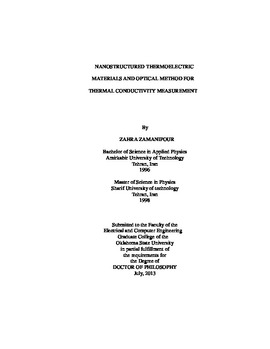| dc.contributor.advisor | Vashaee, Daryoosh | |
| dc.contributor.author | Zamanipour, Zahra | |
| dc.date.accessioned | 2014-09-24T14:17:11Z | |
| dc.date.available | 2014-09-24T14:17:11Z | |
| dc.date.issued | 2013-07 | |
| dc.identifier.uri | https://hdl.handle.net/11244/11056 | |
| dc.description.abstract | A good thermoelectric material has large electrical conductivity, large Seebeck coefficient, and small thermal conductivity. Among the different techniques to achieve small thermal conductivity is the nanostructuring method. In a nanostructured material the thermal conductivity decreases due to the increased interfacial scattering of phonons. In most thermoelectric materials, due to the larger mean free path of phonons compared with electrons, the effect of interfaces on phonon scatterings is more than on carrier scattering. Therefore, reduction of the thermal conductivity becomes possible with almost no or small change in the electrical conductivity via nanostructuring. | |
| dc.description.abstract | The materials that have shown large power factor but have small efficiency due to their large thermal conductivity are good candidates for nanostructuring. For high temperature applications, several transition metal silicides have shown high power factor while they have large thermal conductivity. While silicides have been investigated in crystalline and polycrystalline form in the past, their nanostructuring had not been pursued extensively at the time that this research started. In this PhD dissertation, we have developed several nanostructured materials based on transition metal silicides. | |
| dc.description.abstract | In the path to develop high temperature thermoelectric materials, synthesis, structural characterizations, thermoelectric properties measurements, and analysis of the nanostructured bulk Si1-xGex, Higher Manganese Silicide (HMS), Si0.8Ge0.2 structures with CrSi2 nanocrystallite inclusions, and nanocomposites of SiGe-FeSi2 were completed. The synthesis process parameters including powder processing and sintering parameters were derived for each material system. Model calculations for electron and phonon transport were performed in detail to explain the measured data and direct the experiments. Boron precipitation effect on thermoelectric properties of Si0.8Ge0.2 was also studied by analyzing the experimental data and through theoretical calculations. | |
| dc.description.abstract | At the device level, in order to find the optimum metal contact for HMS, an extensive study was performed to find the best electrical contact for HMS thermoelectric devices. | |
| dc.description.abstract | Along with thermoelectric material development, a novel ultrafast optical characterization method for thermal properties measurement and ultrafast carrier dynamics study was also developed. The designed optical system is a new pump-probe arrangement to perform both thermal properties measurement and ultrafast carrier dynamics study in one set up. The existing radial heat flow analysis for thermal properties measurement was extended to three-dimensional heat flow, which is applicable for distinguishing the xyz thermal conductivity of the anisotropic material. | |
| dc.format | application/pdf | |
| dc.language | en_US | |
| dc.rights | Copyright is held by the author who has granted the Oklahoma State University Library the non-exclusive right to share this material in its institutional repository. Contact Digital Library Services at lib-dls@okstate.edu or 405-744-9161 for the permission policy on the use, reproduction or distribution of this material. | |
| dc.title | Nanostructured thermoelectric materials and optical method for thermal conductivity measurement | |
| dc.contributor.committeeMember | Krasinski, Jerzy | |
| dc.contributor.committeeMember | Abdolvand, Reza | |
| dc.contributor.committeeMember | Ede, Kenneth F. | |
| osu.filename | Zamanipour_okstate_0664D_12961.pdf | |
| osu.accesstype | Open Access | |
| dc.type.genre | Dissertation | |
| dc.type.material | Text | |
| thesis.degree.discipline | Electrical Engineering | |
| thesis.degree.grantor | Oklahoma State University | |
